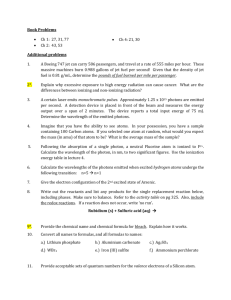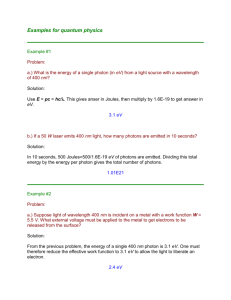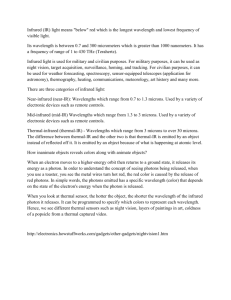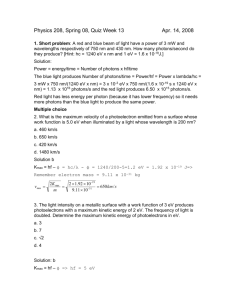Physics 202H - Introductory Quantum Physics I Homework #03
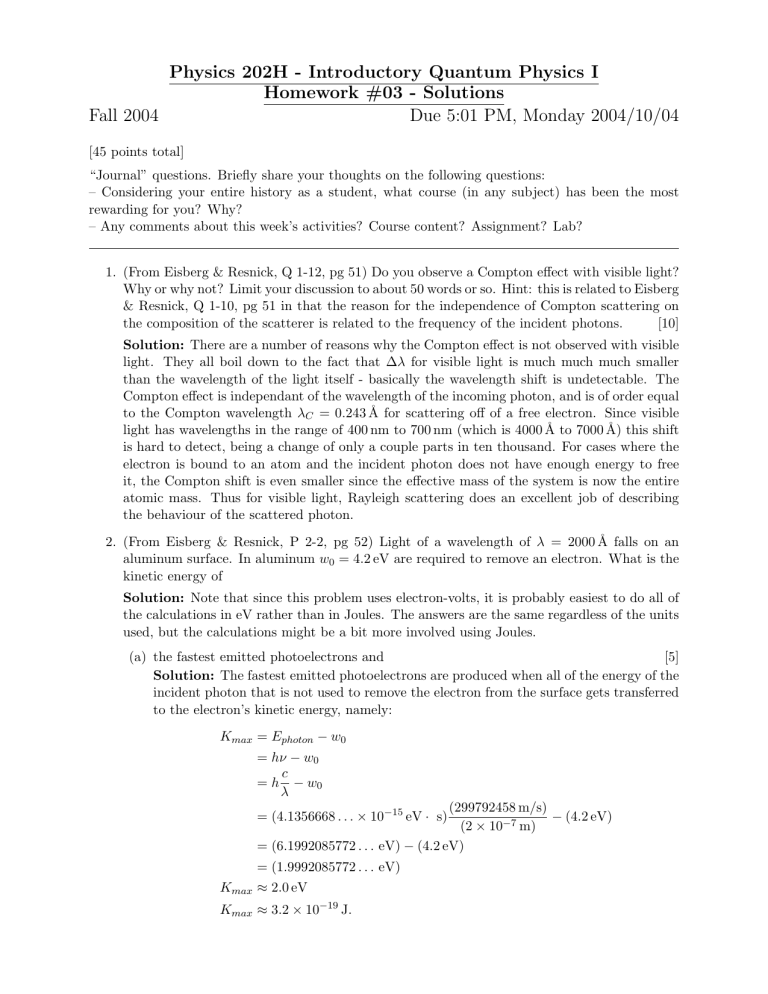
Fall 2004
Physics 202H - Introductory Quantum Physics I
Homework #03 - Solutions
Due 5:01 PM, Monday 2004/10/04
[45 points total]
“Journal” questions. Briefly share your thoughts on the following questions:
– Considering your entire history as a student, what course (in any subject) has been the most rewarding for you? Why?
– Any comments about this week’s activities? Course content? Assignment? Lab?
1. (From Eisberg & Resnick, Q 1-12, pg 51) Do you observe a Compton effect with visible light?
Why or why not? Limit your discussion to about 50 words or so. Hint: this is related to Eisberg
& Resnick, Q 1-10, pg 51 in that the reason for the independence of Compton scattering on the composition of the scatterer is related to the frequency of the incident photons.
[10]
Solution: There are a number of reasons why the Compton effect is not observed with visible light. They all boil down to the fact that ∆ λ for visible light is much much much smaller than the wavelength of the light itself - basically the wavelength shift is undetectable. The
Compton effect is independant of the wavelength of the incoming photon, and is of order equal to the Compton wavelength λ
C
= 0 .
243 ˚ is hard to detect, being a change of only a couple parts in ten thousand. For cases where the electron is bound to an atom and the incident photon does not have enough energy to free it, the Compton shift is even smaller since the effective mass of the system is now the entire atomic mass. Thus for visible light, Rayleigh scattering does an excellent job of describing the behaviour of the scattered photon.
2. (From Eisberg & Resnick, P 2-2, pg 52) Light of a wavelength of λ = 2000 ˚ aluminum surface. In aluminum kinetic energy of w
0
= 4 .
2 eV are required to remove an electron. What is the
Solution: Note that since this problem uses electron-volts, it is probably easiest to do all of the calculations in eV rather than in Joules. The answers are the same regardless of the units used, but the calculations might be a bit more involved using Joules.
(a) the fastest emitted photoelectrons and [5]
Solution: The fastest emitted photoelectrons are produced when all of the energy of the incident photon that is not used to remove the electron from the surface gets transferred to the electron’s kinetic energy, namely:
K max
= E photon
− w
0
= hν − w
0 c
= h
λ
− w
0
= (4 .
1356668 . . .
× 10
− 15 eV · s)
(299792458 m / s)
(2 × 10
− 7 m)
− (4 .
2 eV)
= (6 .
1992085772 . . .
eV) − (4 .
2 eV)
= (1 .
9992085772 . . .
eV)
K max
≈ 2 .
0 eV
K max
≈ 3 .
2 × 10
− 19
J .
(b) the slowest emitted photoelectrons?
[5]
Solution: All of the incident photons have the same wavelength and the same energy, the ejected photoelectrons differ because some of the photon energy may end up being transferred to the bulk metal. The slowest emitted photoelectrons are produced when the energy of the incident photon that is not used to remove the electron from the surface gets transferred to the metal (through collisions or other processes), leaving the electron with virtually no kinetic energy, namely;
K min
≈ 0 eV
K min
≈ 0 J .
(c) What is the stopping potential?
[5]
Solution: The stopping potential is the electric potential (“voltage”) necessary to stop the fastest emitted photoelectrons, namely: eV
0
= K max
= ⇒ V
0
=
=
K max e
(1 .
9992085772 . . .
eV)
(1 e)
= (1 .
9992085772 . . .
V)
V
0
≈ 2 .
0 V .
(d) What is the cutoff wavelength for aluminum?
[5]
Solution: The cutoff wavelength is the smallest wavelength that results in emitted photoelectrons. This wavelength corresponds to the case where the emitted photoelectrons’ maximum kinetic energy is equal to zero, namely:
K max
= E photon
− w
0
= 0 = ⇒ E photon
= w
0 hν cut
= w
0 hν cut
= w
0 c h
λ cut c h w
0
=
= w
λ
0 cut c
λ cut
= h w
0
= (4 .
1356668 . . .
× 10
− 15 eV · s)
(299792458 m / s)
(4 .
2 eV)
= (2 .
9520040844 . . .
× 10
− 7
. . .
m)
λ cut
≈ 2950 ˚
λ cut
≈ 295 nm .
(e) If the intensity of the incident light is 2 .
0 W / m
2
, what is the average number of photons per unit time per unit area that strike the surface?
[5]
Solution: We are given the intensity I , which is the power per unit area, or equivalently the energy per unit time per unit area, and we want to find the photon rate per unit area. Thus we need to know the energy per photon and divide that into the intensity.
For this case it is probably better to use Joules rather than eV, since the problem is stated in terms of W / m
2
. Also be careful not to confuse rate with radiancy , as both are often denoted by the variable R .
R
A
R
A
I
=
E photon
I
= hν
Iλ
=
= hc
(2 .
0 W / m
2
)(2 × 10
− 7 m)
(6 .
626068 . . .
× 10 − 34 J · s)(299792458 m / s)
= (2 .
0136472804 . . .
× 10
18
1 m 2 · s
)
≈ (2 .
0 × 10
18 m 2
1
· s
) .
Thus there are about 2 .
0 × 10 18 incident light.
photons per second per square meter in the beam of
3. (From Eisberg & Resnick, P 2-11, pg 53) An ultraviolet lightbulb, emitting at λ u
= 4000 ˚ and an infrared lightbulb, emitting at λ i
= 7000 ˚
(a) Which bulb radiates photons at the greater rate, and [5]
Solution: Since a photon of ultraviolet light has more energy than a photon of infrared light, it will take a greater rate of infrared photons to deliver 40 W. The answer to the next part of the problem gives the explicit rates.
(b) how many more photons does it produce each second over the other bulb?
[5]
Solution: For the given power P = 40 W, the photon rate is found by dividing by the energy per photon. The energy of the infrared photons will be 4/7 times the energy of the ultraviolet photons, so it will follow that there will be 7/4 times as many infrared photons as ultraviolet photons per unit time, or 3/4 more infrared than ultraviolet. Note that R is the rate of photon emission (with units of photons/sec or just /sec), and has no reference to the area the photons are emitted over. The rate should not be confused with radiancy which is a measure of power per unit area, and also often denoted by R .
For the actual numbers we get:
R i
=
=
P
E i
=
P hν i
P λ i
= hc
(40 W / )(7 × 10
− 7 m)
(6 .
626068 . . .
× 10
− 34 J · s)(299792458 m / s)
R i
= (2 .
0136472804 . . .
× 10
19
= (1 .
4095530963 . . .
× 10
20
1 m 2 · s
)(7)
1 m 2 · s
)
≈ (1 .
41 × 10
20 m 2
1
· s
)
R u
=
=
P
E u
=
P hν u
P λ u
= hc
(40 W / )(4 × 10
− 7 m)
(6 .
626068 . . .
× 10
− 34 J · s)(299792458 m / s)
R u
= (2 .
0136472804 . . .
× 10
19
= (8 .
0545891216 . . .
× 10
19
1 m 2 · s
)(4)
1 m 2 · s
)
≈ (8 .
05 × 10
19 m 2
1
· s
)
To find the difference, we subtract the smaller rate from the larger rate and get
R i
− R u
= (2 .
0136472804 . . .
× 10
19
= (6 .
0409418412 . . .
× 10
19 m 2
1
· s
)(7 − 4) m 2
1
· s
)
R i
− R u
≈ (6 .
04 × 10
19 m 2
1
· s
)
So there are about 6 .
04 × 10
19 more infrared photons than ultraviolet photons produced each second, and as mentioned before, the ratio of the rates is given by the inverse of the ratio of their wavelengths:
R i
7
= = 1 .
75 .
R u
4
Headstart for next week, Week 04, starting Monday 2004/10/04:
– Read Chapter 2.2 “Light as a Particle” in “Simple Nature” by Crowellk
– Read Chapter 2 “Photons – Particlelike Properties of Radiation” in Eisberg & Resnick
– – Section 2.7 “Pair Production and Pair Annihilation”
– – Section 2.8 “Cross Sections for Photon Absorption and Scattering”
– Read Chapter 2.3 “Matter as a Wave” in “Simple Nature” by Crowellk
– Read Chapter 3 “De Broglie’s Postulate – Wavelike Properties of Particles” in Eisberg & Resnick
– – Section 3.1 “Matter Waves”
– – Section 3.2 “The Wave-Particle Duality”


